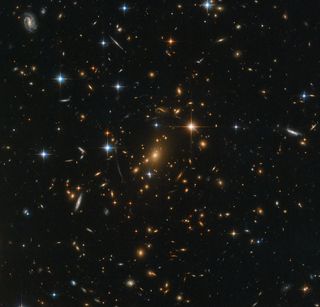Breakthrough Listen Releases 1 Million Gigabytes of Data from Its Search for E.T.

Breakthrough Listen is searching the universe for signals from alien technology, and the project recently announced that its made the largest data release ever in the search for extraterrestrial life.
The $100 million endeavor aims to scan 1 million stars in our neighborhood, 100 nearby galaxies and the plane of the Milky Way. According to a recent statement, the project has already cast a massive net in its quest to catch an alien signal or two. That hasn't happened yet, but the project still has news to report.
In a statement released Tuesday (June 18), Breakthrough Listen said it has collected almost 1 petabyte of digital data, or 1 million gigabytes, which is accessible to the public.
Related: 13 Ways to Hunt Intelligent Aliens
"This data release is a tremendous milestone for the Breakthrough Listen team," Danny Price, Breakthrough Listen Project Scientist for the Parkes Radio Telescope, said in the statement. "We scoured thousands of hours of observations of nearby stars, across billions of frequency channels. We found no evidence of artificial signals from beyond Earth, but this doesn't mean there isn't intelligent life out there: we may just not have looked in the right place yet, or peered deep enough to detect faint signals."
Breakthrough Listen's science team at the University of California, Berkeley's SETI Research Center came up with a way to analyze the large swaths of information for what scientists call "technosignatures." That category represents the potential footprints of technologies like transmitters and propulsion devices, but these signals are difficult to tease out from human-made technological chatter. Researchers described the techniques they are using to review the data in two upcoming studies, according to the statement.
Related: Is Anyone Out There? New SETI Tool Keeps Track of Alien Searches
Get the Space.com Newsletter
Breaking space news, the latest updates on rocket launches, skywatching events and more!
Breakthrough Listen officials say the project's researchers are listening in to a range of radio and optical wavelengths. So far, their ears are the Green Bank Radio Telescope in West Virginia and the Parkes Radio Telescope in Australia, with more facilities set to begin collecting observations soon.
Founded in 2015 by Israeli-Russian billionaire Yuri Milner, Breakthrough Listen has now submitted a broader analysis of 1,327 stars, which officials said is about 80% of its nearby star sample.
"While we have been making smaller subsets of data public before in varying forms and contexts," Matt Lebofsky, lead system administrator of Berkeley's Search for Extraterrestrial Intelligence (SETI) Research Center, said in the statement, "we are excited and proud to offer this first cohesive collection along with an instruction manual, so everybody can dig in and help us search. And we're just getting started — there's much more to come!"
The unpublished papers describing the work of Breakthrough Listen are available on the SETI Berkeley website.
- Get Ready for Milky Way Season with These Galactic Night-Sky Photos
- SETI & the Search for Extraterrestrial Life
- 'Search for Extraterrestrial Intelligence' Needs a New Name, SETI Pioneer Says
Follow Doris Elin Salazar on Twitter @salazar_elin. Follow us on Twitter @Spacedotcom and on Facebook.
Join our Space Forums to keep talking space on the latest missions, night sky and more! And if you have a news tip, correction or comment, let us know at: community@space.com.

Doris is a science journalist and Space.com contributor. She received a B.A. in Sociology and Communications at Fordham University in New York City. Her first work was published in collaboration with London Mining Network, where her love of science writing was born. Her passion for astronomy started as a kid when she helped her sister build a model solar system in the Bronx. She got her first shot at astronomy writing as a Space.com editorial intern and continues to write about all things cosmic for the website. Doris has also written about microscopic plant life for Scientific American’s website and about whale calls for their print magazine. She has also written about ancient humans for Inverse, with stories ranging from how to recreate Pompeii’s cuisine to how to map the Polynesian expansion through genomics. She currently shares her home with two rabbits. Follow her on twitter at @salazar_elin.
